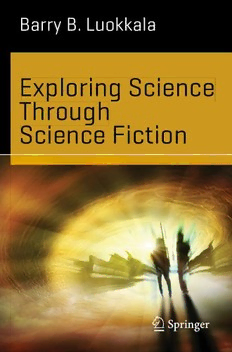Table Of ContentBarry B. Luokkala
EEExxxppplllooorrriiinnnggg SSSccciiieeennnccceee
TTTThhhhrrrroooouuuugggghhhh
SScciieennccee FFiiccttiioonn
ScienceandFiction
EditorialBoard
MarkAlpert
PhilipBall
GregoryBenford
MichaelBrotherton
VictorCallaghan
AmnonHEden
NickKanas
GeoffreyLandis
RudiRucker
DirkSchulze-Makuch
RudyVaas
UlrichWalter
StephenWebb
For furthervolumes:
http://www.springer.com/series/11657
Science and Fiction – A Springer Series
This collection of entertaining and thought-provoking books will appeal equally to
sciencebuffs,scientistsandscience-fictionfans.Itwasbornoutoftherecognitionthat
scientific discovery and the creation of plausible fictional scenarios are often two sides
ofthesamecoin.Eachreliesonanunderstandingofthewaytheworldworks,coupled
withtheimaginativeabilitytoinventneworalternativeexplanations—andevenother
worlds.Authoredbypracticingscientistsaswellaswritersofhardsciencefiction,these
books explore and exploit the borderlands between accepted science and its fictional
counterpart. Uncovering mutual influences, promoting fruitful interaction, narrating
and analyzing fictional scenarios, together they serve as a reaction vessel for inspired
new ideas in science, technology, and beyond.
Whether fiction, fact, or forever undecidable: the Springer Series “Science and
Fiction” intends to go where no one has gone before!
Itslargelynon-technicalbookstakeseveraldifferentapproaches.Journeywiththeir
authors as they
(cid:129) Indulgeinsciencespeculation—describingintriguing,plausibleyetunprovenideas;
(cid:129) Exploit science fiction for educational purposes and as a means of promoting
critical thinking;
(cid:129) Exploretheinterplayofscienceandsciencefiction—throughoutthehistoryofthe
genre and looking ahead;
(cid:129) Delveintorelatedtopicsincluding,butnotlimitedto:scienceasacreativeprocess,
the limits of science, interplay of literature and knowledge;
(cid:129) Tell fictional short stories built around well-defined scientific ideas, with a
supplement summarizing the science underlying the plot.
Readerscanlookforwardtoabroadrangeoftopics,asintriguingastheyareimportant.
Here just a few by way of illustration:
(cid:129) Time travel, superluminal travel, wormholes, teleportation
(cid:129) Extraterrestrial intelligence and alien civilizations
(cid:129) Artificial intelligence, planetary brains, the universe as a computer, simulated
worlds
(cid:129) Non-anthropocentric viewpoints
(cid:129) Synthetic biology, genetic engineering, developing nanotechnologies
(cid:129) Eco/infrastructure/meteorite-impact disaster scenarios
(cid:129) Future scenarios, transhumanism, posthumanism, intelligence explosion
(cid:129) Virtual worlds, cyberspace dramas
(cid:129) Consciousness and mind manipulation
Barry B. Luokkala
Exploring Science
Through Science
Fiction
BarryB.Luokkala
DepartmentofPhysics
CarnegieMellonUniversity
Pittsburgh,USA
ISSN2197-1188 ISSN2197-1196(electronic)
ISBN978-1-4614-7890-4 ISBN978-1-4614-7891-1(eBook)
DOI10.1007/978-1-4614-7891-1
SpringerNewYorkHeidelbergDordrechtLondon
LibraryofCongressControlNumber:2013945865
©SpringerScience+BusinessMediaNewYork2014
Thisworkissubjecttocopyright.AllrightsarereservedbythePublisher,whetherthewholeorpart
of the material is concerned, specifically the rights of translation, reprinting, reuse of illustrations,
recitation,broadcasting,reproductiononmicrofilmsorinanyotherphysicalway,andtransmissionor
informationstorageandretrieval,electronicadaptation,computersoftware,orbysimilarordissimilar
methodologynowknownorhereafterdeveloped.Exemptedfromthislegalreservationarebriefexcerpts
inconnectionwithreviewsorscholarlyanalysisormaterialsuppliedspecificallyforthepurposeofbeing
enteredandexecutedonacomputersystem,forexclusiveusebythepurchaserofthework.Duplication
ofthispublicationorpartsthereofispermittedonlyundertheprovisionsoftheCopyrightLawofthe
Publisher’s location, in its current version, and permission for use must always be obtained from
Springer.PermissionsforusemaybeobtainedthroughRightsLinkattheCopyrightClearanceCenter.
ViolationsareliabletoprosecutionundertherespectiveCopyrightLaw.
The use of general descriptive names, registered names, trademarks, service marks, etc. in this
publicationdoesnotimply,evenintheabsenceofaspecificstatement,thatsuchnamesareexempt
fromtherelevantprotectivelawsandregulationsandthereforefreeforgeneraluse.
While the advice and information in this book are believed to be true and accurate at the date of
publication,neithertheauthorsnortheeditorsnorthepublishercanacceptanylegalresponsibilityfor
anyerrorsoromissionsthatmaybemade.Thepublishermakesnowarranty,expressorimplied,with
respecttothematerialcontainedherein.
Printedonacid-freepaper
SpringerispartofSpringerScience+BusinessMedia(www.springer.com)
To Janet,
the love of my life and wife of my youth,
and
To Joseph,
who had the courage to go where no
elementary school teacher had gone before.
Preface
Science and science fiction have been passions of mine since childhood. But the
combinationofthetwo—usingsciencefictionasavehicleforteachingscience—is
something that I only began to explore in relatively recent years. We live in an
increasinglytechnologicalworld,inwhichitisincreasinglyimportantforpeopleto
bescientificallyinformed.Buttraditionalcoursesinscienceatthecollegelevelare
usuallygearedtowardstudentswhoarealreadyontheirwaytowardcareersrelated
to science, technology, engineering, or mathematics—the so-called STEM fields.
Although there are some notable exceptions, most of the offerings in science for
students in the fine arts, humanities, and social sciences continue to be watered-
down versions of courses intended for science or engineering students. Students
whotakesuchcoursesoftendososimplytofulfilladegreerequirementandwitha
sense of trepidation. They often complete such courses with no more interest
in science than when they signed up. The present work has one primary goal: to
makescienceaccessibletoabroadaudience,includingbothnontechnicalstudents
andtechnicallyorientedstudents,withaviewtowardincreasingpublicawareness
ofandinterestinscience.
Content and Scope
The content of the book is organized around seven major questions, which are
frequently addressed in works of science fiction: What is the nature of space and
time?What istheuniversemadeof?Canamachineever become conscious?Are
we alone inthe universe? What does it mean to be human? How do we solve our
problems?Whatliesahead?Thereisadeliberateprogressioninthesesevenmajor
questions, beginning with the most objective (changing perspectives through his-
tory concerning the nature of space and time, the fundamental building blocks of
matter, and the properties of materials), followed by topics which have both
objectiveandsubjectivedimensions(Isconsciousnesscomputable?Isthereintelli-
gentlifeelsewhereintheuniverse?What,ifanything,setshumansapartfromother
vii
viii Preface
closelyrelatedspecies?),andendingwithquestionsthatmaybemorecontroversial
and speculative (How do we distinguish between science and pseudoscience?
How isscience used ormisusedinattemptstosolvethe problemsfacing society?
Whatwillthefutureholdforourtechnologicalsociety?).Inadditiontothemajor
questions, each of the chapters includes suggestions for further exploration, with
morespecificquestionsandreferencestoscientificliterature.
Muchoftheemphasisinthisbookreflectsmytrainingasaphysicist.YetIdonot
subscribe to the narrow view of science held by Ernest Rutherford, a famous
physicistoftheearlytwentiethcentury,whoproclaimed,“Allofscienceisphysics.
The rest is stamp-collecting.” A few of my colleagues have an even more narrow
view toward science than Rutherford and will tell you that you aren’t even doing
physicsunlessyouaredoingtheirparticularbrandofphysics.Whenitcomestoa
discussionofwhatisscience,Iamwillingtoembraceconsiderablymorediversity.
Yettherearelimits.Aseriousdiscussionofwhatisscienceandwhatisnotscience
is also included in this book. Not all forms of human inquiry are rightly included
undertheumbrellaofscience.
The Approach
Sciencefictionisusedthroughoutthisbookasaspringboardfordiscussingboththe
fundamental principles of science and cutting-edge science research. Short scenes
fromsciencefictionmoviesandtelevisionepisodesarecritiquedinlightofourcurrent
understandingofscience.Classdiscussionfocusesondiscerningthelevelofplausi-
bilityofthesciencedepictedineachscene.Tothisend,fourgeneralcategoriesare
useful. A handful ofexamples fromsome of the best movies turn out tobe solidly
basedongoodscience—thethingsthatweseeonthescreenareactuallyknownto
happen,essentiallyasdepictedorasdescribedinthedialog.Anexamplethatfallsinto
thisfirstcategoryistherelativistictimedilationdescribedintheopeningsceneofthe
original(1967)versionofthePlanetoftheApes.Asecondcategoryincludesthings
whicharepossibleinprinciple,butbeyondourcurrenttechnology.Thatistosay,it
hasn’t happened yet, but there is nothing in the laws of science to forbid it from
happening.An example is thesentientandroid,Commander Data, inthe TV series
Star Trek: The Next Generation. A third category is stuff that just can’t happen as
shown.Muchofsciencefictionmaybelotsoffuntowatch,butissimplyimpossible,
andwewillexplorethereasonswhy.Anexampleofthisistheextraordinarilyrapid
rateatwhichtheairleaksoutofaninterplanetaryspaceship,afterbeingpuncturedby
a micrometeoroid, in the 2000 movie Mission to Mars. Using a reasonable set of
assumptions,wewillcomeupwithanestimateofhowlongitwouldreallytakeand
concludethatthescreenwriterssimplywantedtoheightenthesenseofexcitementand
danger.Afourthcategoryisonethatisgrowingrapidlyasourtechnologyadvances:
thingswhichwerepurelysciencefictionatthetimethatthemovieorTVepisodewas
produced,butarenowpartofrealityorareexpectedtobecomepartofrealityinthe
very near future. When the movie GATTACA was produced in 1997, the Human
Preface ix
Genome Project had not yet been completed, and the concept of rapid DNA
sequencing, as shown in the movie, was purely in the imagination of the writers.
It took an enormous government-funded research project 13 years to complete the
sequencingofthefirsthumangenome.Full-genomesequencingcannowbedonein
about1dayatacostofabout$1,000.
Plausibility Checks and Quantitative Estimations
Someofthesci-fiillustrationsareconducivetodoingwhatwemightcallaquantita-
tive plausibility check. That is to say, by watching the movie scene we can gather
enoughinformationtodoaroughcalculationandthendecideifwhatweseecould
actually happen or not. In the text I call these Estimation Problems. The objective
ineachcaseisnottoobtainaspecificanswer,whichiseitherrightorwrong(thesort
ofproblemsencounteredinmostintroductoryphysicstextbooks).Instead,theideais
tocomeupwithanestimate,bymakingareasonablesetofassumptionstosupplement
theinformationyoucangatherdirectlyfromthemoviescene.Forexample,howmuch
power would be required for a handheld weapon, such as a Star Trek phaser,
tovaporizeahumanbody?Theanswerthatyougetwilldependonwhatassumptions
youmakeabouthowlongthevaporizationprocesstakes(fromwatchingarelevant
scene)andaboutwhatthehumanbodyismadeof.Thenontechnicalstudentshould
notbeintimidatedbythefrequentuseofequationsinsomeofthechapters.Where
calculationscanbedone,exampleproblemsareworkedoutinthetext,andadditional
problemsareproposedforyoutoworkoutonyourown.SolutionsfortheseEstima-
tionProblemsareincludedinanappendix.
Movie, TV, and YouTube References
Collectively, the chapters include over 180 references to specific scenes in
130differentmoviesandtelevisionepisodes,spanningover100yearsofcinematic
history. In general, but with a few notable exceptions, I refrain from passing
judgment on these works from an artistic perspective. Some of the very worst
sci-fi movies ever made actually include some rather useful illustrations and are
likelytopromotevery fruitfuldiscussions inclass. Each chapter includesalistof
referencestomovieandTVscenes,intheorderthattheyarecitedinthetext.The
entire collection of movies and TV episodes cited in the text is also included
alphabeticallyinappendicesattheendofthebook.
Most of the visual material is available on DVD and is referenced by scene
numberforeaseinselectingthedesiredsceneforaclassroompresentation.Afew
ofthescenesfromthemostrecentTVseriesepisodeshadnotyetbeenreleasedon
DVDatthetimeofpublicationorarenotyetpartofmypersonalDVDcollection.
Thesearecitedbyseasonnumber,episodenumber,andairdate.

